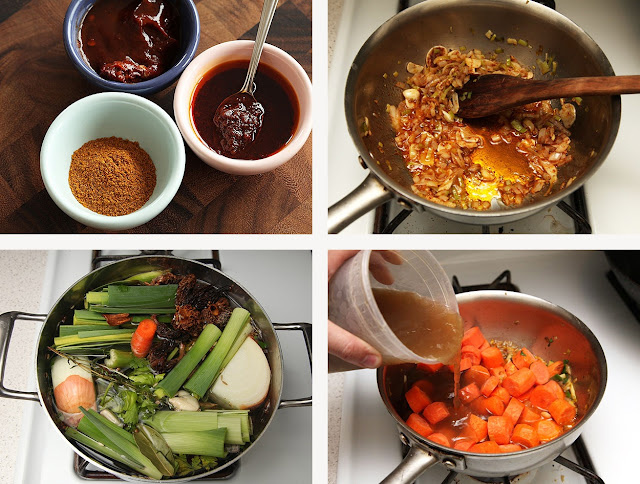The Food Lab: How to Make Creamy Vegetable Soups Without a Recipe | Serious Eats
A blueprint for making any creamy vegetable soup.
For instance: a smooth carrot soup flavored with ginger and harissa.
The magic lies in the way that aromatic ingredients can intensify and bring out other flavors, as well as the way in which liquids coat your mouth, giving more direct contact to your taste buds and olfactory sensors, and making for easier release of volatile compounds.
Step 1. Prepare Your Main Ingredient:
- the smaller you cut, the quicker your soup will cook down the line.
-
roasting or browning: effective technique for sweet, dense vegetables like sweet potatoes and squashes, or brassicas like broccoli or cauliflower.
How: toss with some olive oil, salt, and pepper, roast at 190C.
Step 2. Choose Your Aromatics:
- alliums—onions, leeks, shallots, garlic.
Diced carrots, bell peppers, celery, thinly sliced fennel, or ginger can work well in certain situations.
- Nearly every soup I make
starts with either
onions or leeks, along with some garlic or shallot (and sometimes all four!) cooked down in olive oil or butter.
Step 3. Sweat Or Brown Your Aromatics.
- sweating is the process of slowly cooking chopped vegetables in a fat over moderate heat.
- browning starts out like sweating, but generally takes place over higher heat.
 Step 4.
Step 4. Add Second-level Aromatics Like Spices And Pastes.
- these are things like ground spices (say,
curry powder, ground cumin, or chili powder), and moist pastes (like
tomato paste, harissa, or chopped chipotle peppers in adobo sauce).
The process only takes a few moments—just until the spices start smelling fragrant.
For this carrot soup I'm using spicy
harissa paste, along with some
cumin and coriander seed.
Step 5. Add Your Liquid.
- chicken stock
- vegetable stock
- vegetable juice
- dairy such as milk or buttermilk
After adding your liquid and main ingredient bring it to a
simmer, and let it cook until the vegetables are just cooked through; you want them to be just tender enough to pierce with a knife with no resistance.
 Step 6.
Step 6. Purée And Emulsify
- A blender
- An immersion blender
- a food processor should be your last choice.
Exception: potatoes.
Cook the potatoes in liquid, then drain and press them through a ricer, food mill.
Whisking the pressed potato back into the soup to thicken it.
Whatever method you choose to purée, I like to
emulsify my soup with some fat during this stage—either
butter or olive oil.
Step 7. Finish With Acid And Season.
- important to bring out the best flavor in a recipe is acid.
For most vegetable-based dishes,
lemon juice or lime juice is a great option.
Good options would be a dash of
cider vinegar, wine vinegar, or my favorite, sherry vinegar.
Step 8. Garnish And Serve.
- a scattering of fresh chopped herbs and a drizzle of olive oil.
Here are
some other options:
Flavorful oils, like walnut, pistachio, squash seed, or argan.
- Chopped fresh herbs or tender alliums like parsley, tarragon, chives, or sliced scallions.
- Sautéed vegetables like mushrooms, leeks, or garlic.
- Nuts toasted in olive oil or butter, like almonds, hazelnuts, or pine nuts.
- Simple gremolata-style mixtures, like a blend of parsley, lemon zest, and grated garlic.
- Thinly sliced chilies.
- A drizzle of browned butter.
- Dairy products like sour cream, crème fraîche, or heavy cream; plain or flavored with spices or pastes. Using a hint of the same spice you used earlier in step 4 can be a good way to boost flavor.
 Step 9.
Step 9. Rinse And Repeat.
Once you've got these
eight basic steps down, you've got what it takes to start creating any number of creamy soups, combining any flavors you like.





